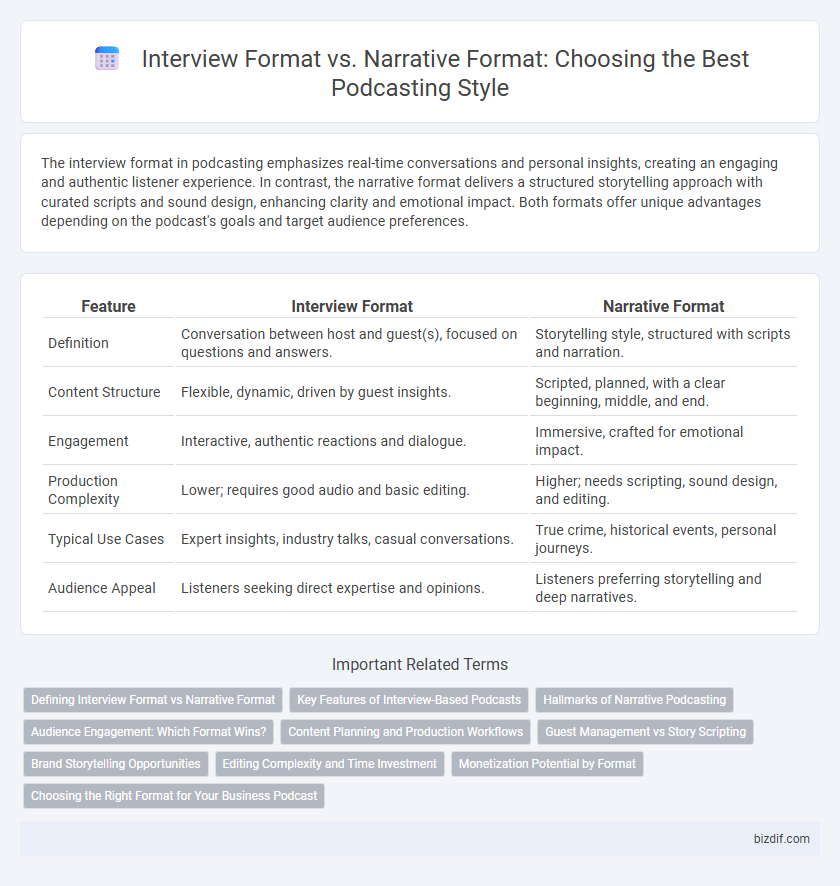The interview format in podcasting emphasizes real-time conversations and personal insights, creating an engaging and authentic listener experience. In contrast, the narrative format delivers a structured storytelling approach with curated scripts and sound design, enhancing clarity and emotional impact. Both formats offer unique advantages depending on the podcast's goals and target audience preferences.
Table of Comparison
| Feature | Interview Format | Narrative Format |
|---|---|---|
| Definition | Conversation between host and guest(s), focused on questions and answers. | Storytelling style, structured with scripts and narration. |
| Content Structure | Flexible, dynamic, driven by guest insights. | Scripted, planned, with a clear beginning, middle, and end. |
| Engagement | Interactive, authentic reactions and dialogue. | Immersive, crafted for emotional impact. |
| Production Complexity | Lower; requires good audio and basic editing. | Higher; needs scripting, sound design, and editing. |
| Typical Use Cases | Expert insights, industry talks, casual conversations. | True crime, historical events, personal journeys. |
| Audience Appeal | Listeners seeking direct expertise and opinions. | Listeners preferring storytelling and deep narratives. |
Defining Interview Format vs Narrative Format
The interview format in podcasting centers on conversations between a host and guest, emphasizing real-time dialogue and personal insights. Narrative format involves scripted storytelling, using voiceovers, sound design, and structured segments to convey a cohesive story. Both formats serve distinct listener preferences, with interviews offering authenticity and narratives providing immersive experiences.
Key Features of Interview-Based Podcasts
Interview-based podcasts prioritize direct conversations between hosts and guests, emphasizing authentic dialogue and spontaneous insights. They typically feature real-time Q&A, personalized storytelling, and diverse guest perspectives to engage listeners. This format excels in delivering expert opinions, insider knowledge, and dynamic interactions that enhance content credibility and listener connection.
Hallmarks of Narrative Podcasting
Narrative podcasting is characterized by a structured storytelling approach, often featuring a clear beginning, middle, and end that engage listeners emotionally and intellectually. It employs sound design, voice acting, and dramatic pacing to create immersive experiences that go beyond traditional interviews. Key hallmarks include carefully crafted scripts, layered audio elements, and a focus on thematic depth to build compelling, cohesive stories.
Audience Engagement: Which Format Wins?
Interview format fosters direct interaction and authenticity by featuring real-time conversations and diverse perspectives, enhancing audience connection and trust. Narrative format captivates listeners through storytelling, structured plots, and emotional arcs, creating immersive experiences that boost listener retention. Audience engagement tends to peak when podcasts blend both formats, leveraging the authenticity of interviews with the compelling drive of narratives.
Content Planning and Production Workflows
Interview format in podcasting requires detailed content planning to prepare questions and anticipate guest responses, streamlining production workflows by focusing on real-time interaction and organic dialogue. Narrative format demands extensive scripting, storyboarding, and layered editing to ensure a coherent storyline and immersive listener experience. Efficient production workflows for narrative podcasts often involve multiple stages of voiceover recording, sound design, and post-production refinement to maintain pacing and engagement.
Guest Management vs Story Scripting
Interview format podcasting emphasizes dynamic guest management, requiring hosts to engage, guide, and adapt to real-time responses to draw out authentic insights and maintain listener interest. Narrative format relies heavily on meticulous story scripting, structuring episodes with a clear beginning, middle, and end to craft a compelling, cohesive storyline that resonates emotionally with the audience. Both formats demand tailored preparation: interviews focus on research and question design for smooth guest interaction, while narratives prioritize scriptwriting and pacing to enhance storytelling effectiveness.
Brand Storytelling Opportunities
Interview format in podcasting excels at showcasing authentic voices, allowing brands to build trust through real conversations and diverse perspectives. Narrative format offers structured storytelling with crafted arcs, ideal for conveying complex brand histories and emotional journeys that deepen audience connection. Combining both formats maximizes brand storytelling by blending personal insights with compelling narratives to enhance engagement and memorability.
Editing Complexity and Time Investment
Interview format podcasts typically require less editing due to the natural conversational flow, making post-production faster and more straightforward. Narrative format podcasts demand meticulous editing to craft a cohesive story, often involving scripting, sound design, and multiple audio layers. The time investment for narrative podcasts is significantly higher, reflecting the complexity of structuring episodes for storytelling impact.
Monetization Potential by Format
Interview format podcasts generate higher monetization opportunities due to direct audience engagement, guest sponsorships, and dynamic ad placements, attracting brands seeking targeted marketing. Narrative format podcasts benefit from consistent storytelling that fosters loyal listenership and enables lucrative subscription models, exclusive content, and merchandising. Advertisers often prefer interview formats for real-time brand integration, while narrative formats maximize revenue through crowdfunding and premium episodes.
Choosing the Right Format for Your Business Podcast
Selecting the optimal podcast format depends on your business goals and audience engagement preferences. Interview formats foster authentic conversations with industry experts, enhancing credibility and network reach, while narrative formats deliver structured storytelling that boosts listener retention and brand messaging clarity. Analyzing your target demographic's content consumption habits and your content objectives ensures the chosen format effectively drives brand awareness and customer loyalty.
Interview Format vs Narrative Format Infographic

 bizdif.com
bizdif.com